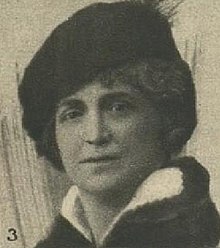Jindřiška Flajšhansová
Jindřiška Flajšhansová (4 September 1868 – 30 May 1931) was a Czech teacher, editor, and women's rights activist. Trained as a teacher, when she married, Flajšhansová was forced to give up the profession. She turned her attention to the issues of disability and women's concerns. Becoming an advocate for people with sight difficulties, she supported the use of
Early life and education
Jindřiška Kakšová was born on 4 September 1868, in Sedlčany, in the Kingdom of Bohemia, to Marie (née Sršňová) and Ludvík Pravoslav Kakš.[1] Her mother was a personal friend of Jan Neruda and after her marriage, he became a life-long family friend, as well as her correspondent.[2] Her father was a lawyer, and practised in Slaný. He also dabbled in theatre and wrote librettos.[2][3] Her brother, Jan, was also musical but studied law. Kakšová had few options to further her education at the time and decided to study teaching.[3] She graduated from the Czech Institute for the Education of Female Teachers in Prague around 1889.[4][5]
Career
Upon her graduation, Kakšová taught for five years before marrying
In 1910, when declining health forced Krásnohorská to retire,[10] Flajšhansová became the chair of the Czech Women's Industrial Association. Within two years, she also became the editor of Ženské listy.[3] Besides publishing original articles in the journal, Flajšhansová translated works from other authors working in the women's movement internationally.[7] The focus of the magazine was to publish literary works from women authors and provide practical educational advice on running a household, medicine and hygiene, training and employment. As World War I was approaching, the magazine increasingly focused on politics.[12] Flajšhansová, as a pacifist, advocated for peaceful solutions.[13] As the war continued, the magazine did not face censorship like other feminist publications, as it espoused largely conservative views. It increasingly became a survival manual on how to get through the war.[14]
Despite the financial struggles that continued to plague the organisation and the magazine,[15][16] Flajšhansová refused to allow it to become affiliated with any specific political party.[11] In 1921, she tried to resign from the editorship and pass the job over to Maryša Šárecká and Pavla Moudrá, but the change was unsuccessful. From 1923, she was able to have František Sekanina take on most of the editorial duties.[14] She finally stepped away from editing the journal in 1926, when it ceased publication, because of a lack of funding.[3][17] That year, Krásnohorská died and Flajšhansová began pressing for a monument to be installed in Charles Square in her honour.[17][18]
Death and legacy
Flajšhansová died suddenly on 30 May 1931, the day before the monument to Krásnohorská was to be unveiled. Both women were honoured during the dedication ceremony, which took place on 31 May. She was remembered for her dedication to issues which impacted women and girls and her work to preserve the memory of Krásnohorská.[18]
References
Citations
- ^ Birth record 1868, p. 193.
- ^ a b Novotný 1965, p. 577.
- ^ a b c d e f Vošahlíková 2020.
- ^ Czech Institute 1901, p. 148.
- ^ a b Najmanová 2011, p. 36.
- ^ Výroční zpráva 1931.
- ^ a b Najmanová 2011, p. 37.
- ^ Najmanová 2011, pp. 37–38.
- ^ Sayer 1998, p. 90.
- ^ a b Najmanová 2011, p. 39.
- ^ a b Garver 1985, p. 75.
- ^ Heczková 2009, p. 78.
- ^ Heczková 2009, p. 77.
- ^ a b Heczková 2009, p. 79.
- ^ Heczková 2009, pp. 78–79.
- ^ Najmanová 2011, p. 40.
- ^ a b Heczková 2009, p. 80.
- ^ a b Najmanová 2011, p. 41.
Bibliography
- Garver, Bruce M. (1985). "4. Women in the First Czechoslovak Republic". In Wolchik, Sharon L.; Meyer, Alfred G. (eds.). Women, State, and Party in Eastern Europe. Durham, North Carloina: ISBN 978-0-8223-0660-3.
- Heczková, Libuše (2009). Píšící Minervy: Vybrané kapitoly z dějin české literární kritiky [Writing Minerva: Selected Chapters from the History of Czech Literary Criticism] (in Czech). Prague: Filozofická Fakulta Univerzity Karlovy. ISBN 978-80-7308-830-9.
- Najmanová, Veronika (2011). Zapomenuté představitelky Ženského výrobního spolku českého ve světle jejich pozůstalosti a dobového tisku [Forgotten Representatives of the Czech Women's Production Association in the Light of their Legacy and Contemporary Press] (PDF) (Thesis) (in Czech). Prague: Charles University. Archived (PDF) from the original on 14 September 2022. Retrieved 14 September 2022.
- Novotný, Miloslav, ed. (1965). "23. Do Knína 5. června (1860) [23. To Knin on June 5 (1860)]" (PDF). Jan Neruda, Dopisy III [Jan Neruda, Letters III] (in Czech). Prague: Státní Naklad. p. 577. OCLC 248287731. Archived from the original(PDF) on 14 September 2022.
- Sayer, Derek (1998). The Coasts of Bohemia: A Czech History. Princeton, New Jersey: ISBN 978-0-691-05052-2.
- Vošahlíková, Pavla (17 August 2020). "Flajšhansová Jindřiška 4.9.1868-30.5.1931" [Jindřiška Flajšhansová 4 September 1868-30 May 1931]. Biografický slovník českých zemí (in Czech). Prague: Historical Institute of the Academy of Sciences of the Czech Republic. Archived from the original on 14 June 2021. Retrieved 14 September 2022.
- "Jindřiška Flajšhansová". Výroční zpráva (in Czech). 30 (1). Prague: Ženský výrobní spolek český: 5–15. 1931. ISSN 1803-3598.(subscription required)
- "Matriční záznam o narození a křtu farnost Sedlčany: Jindřiška Zulia Kakšová" [Registry Record of Birth and Baptism in the Sedlčany Parish: Jindřiška Zulia Kakšová]. State Regional Archive in Prague (in Czech). Prague, Czech Republic: Roman Catholic Church. 4 September 1868. p. 193. Retrieved 14 September 2022.
- "Seznam Ućitelek, které složily maturitu na c. kr. ústavu učitelek v Praze od roku 1871–1900 [List of Teachers Who Have Passed the Matriculation Examination at the Czech Institute of Female Teachers in Prague from 1871–1900]". Památník českých učitelek u příležitosti třicáté ročnice c.k. českého ústavu ku vzdělání učitelek v Praze [Memorial to Czech Female Teachers on the Occasion of the Thirtieth Anniversary of the Czech Institute for the Education of Female Teachers in Prague] (in Czech). Prague: Českého ústavu ku vzdělání učitelek. 1901. pp. 141–154.

